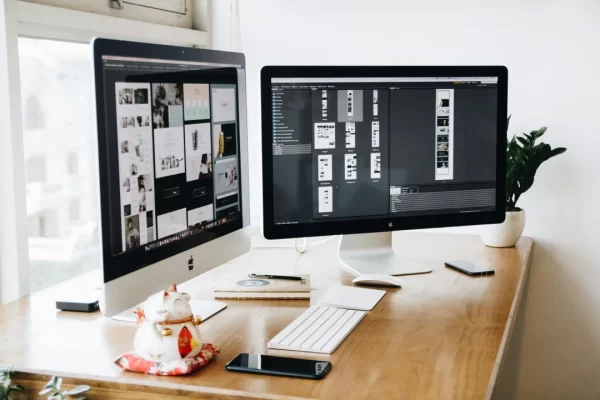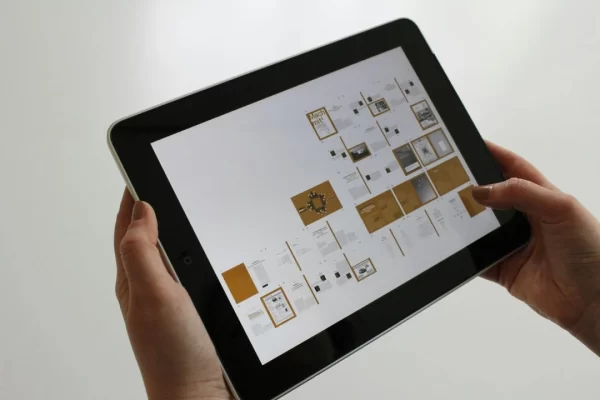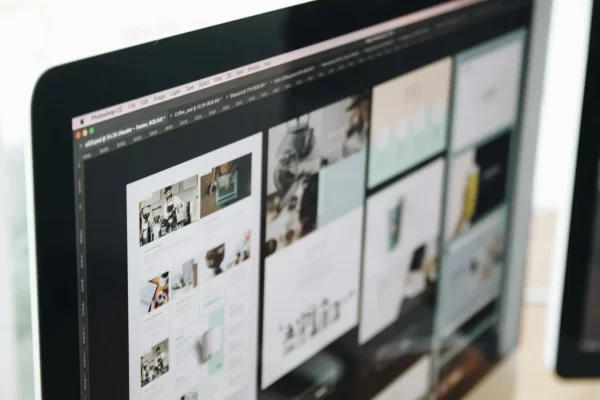In today’s fast-paced digital world, trends in web design evolve rapidly—shaped by user behaviour, emerging technology, and the demand for better digital experiences. From bold visuals and nostalgia-driven layouts to interactive storytelling and dynamic typography, 2024 is ushering in a new era of creativity and functionality in web design.
To stay relevant and competitive, businesses must understand these evolving patterns and leverage them to craft engaging, user-centric websites. In this article, we explore the latest web design trends shaping the digital landscape in 2024 and how they can be used to elevate your brand online.
Key Takeaways
- Oversized text and dynamic typography boost clarity and engagement.
- Y2K and Glassmorphism bring visual nostalgia and futuristic vibes.
- Motion effects and interactive storytelling enhance user experience.
- Visible borders and vibrant gradients help guide user attention.
- Staying on top of design trends ensures relevance, UX excellence, and competitive advantage.
Table of Contents
Current Trends in Web Design for 2024
Here are some top web design trends expected to dominate the market and influence web design experts this year:
Oversized Text
Big, bold text is becoming a powerful tool for minimalistic web designs. Oversized headings help communicate key messages instantly and reduce the need for cluttered graphics. It’s especially effective on service pages or hero sections where clarity is key. Paired with clean sans serif fonts, this trend improves readability and adds modern flair.
Y2K Effects
Nostalgia is influencing modern design, with Y2K-inspired visuals—neon hues, static textures, and pixelated fonts—making a comeback. These retro aesthetics are being used across portfolios, marketing websites, and tech brands to evoke a sense of familiarity and fun. It’s a clever way to connect emotionally with users through design.
UX-Focused Design
Websites in 2024 are hyper-focused on user experience. From intuitive navigation and AI-powered recommendations to lightning-fast page loads and clean layouts, the priority is giving visitors what they need quickly and effortlessly. Brands that invest in UX will see higher engagement and stronger conversions.
Vibrant Gradients
Gradients are back—but bolder and more sophisticated than before. Designers are using gradients in backgrounds, buttons, and images to create visual interest. They’re especially effective for drawing attention to CTAs and elevating sections that need more personality, without overpowering the rest of the design.
Motion Effects On The Home Page
Motion adds life to websites—when done right. Scroll animations, hover states, and micro-interactions offer dynamic engagement without overwhelming the user. These effects subtly guide users through content and help emphasize key offerings. The key is using them sparingly for speed and accessibility.
Here are a few other ways to add motion effects on the home page:
- Hover animation
- Loading animation
- Accent animation
- Moving elements
Interactive Storytelling
Storytelling is evolving into immersive, interactive journeys. By blending visuals, animations, and scroll-triggered narratives, brands are building stronger emotional connections. Whether you’re telling your brand story or explaining a product, interactive storytelling keeps users engaged and increases time on site.
Glassmorphism For The Hero Section
Glassmorphism—featuring blurred, translucent panels—is making hero sections feel futuristic and elegant. This trend works well with minimalistic interfaces and makes content feel layered and dynamic. It’s great for tech startups and modern brands wanting to appear polished yet approachable.
Clear Or Visible Borders
Defined borders are helping to organise content visually without complicating the design. This clean separation makes product images or featured sections stand out while improving user navigation. The aesthetic feels modern, especially when used with subtle shadows or neutral tones.
Dynamic Typography
Kinetic typography—animated or moving text—draws attention fast. Designers are using this on hero banners and headline sections to engage users from the moment they land on a page. It offers a simple way to add motion while keeping things clean and content-focused.
Why Web Design Trends Matter
Web design trends play an important role in increasing user engagement and creating memorable experiences. Following the current trends enables designers and developers to:
Maintain Relevance
Websites that look to be out of date may turn off visitors and undermine a brand’s credibility. Adopting current design trends demonstrates that your website is up-to-date and relevant.
Improve User Experience
Many design trends are centred on improving user experiences, making navigation simple, and content consumption delightful. Prioritising user experience can lead to higher conversion rates and customer satisfaction.
Stay Competitive
Standing out from the crowd is critical in today’s competitive online market. Incorporating unique design features can help set your website apart from others in your sector.
Update Your Website Today!
The influence of web design trends extends far beyond mere aesthetics, shaping how users perceive and engage with websites. Keeping abreast of the latest design trends transcends mere fashion-following; it is a strategic endeavour to deliver unparalleled user experiences and secure a competitive advantage in the digital landscape. To create innovative and visually striking websites that leave an indelible mark on the audience, it is crucial to not only embrace the right trends but also foster a sense of curiosity and a commitment to continuous learning.
Stay ahead in the digital landscape by ensuring your website is not only up to date but also seamlessly incorporates the latest trends. Our expert team at Digital Rescue specialises in crafting cutting-edge websites that capture attention and elevate user experiences. Trust us to bring your vision to life while safeguarding your website’s overall performance. Don’t just keep up; lead the way with Digital Rescue. Contact us now to transform your digital presence.
Frequently Asked Questions (FAQ)
What are the most important web design trends in 2024?
Some of the key trends include oversized text, interactive storytelling, motion effects, Glassmorphism, and user-centric designs powered by AI.
How do design trends affect website performance?
When implemented correctly, design trends can improve engagement, readability, and conversion rates. However, overuse—especially of animations—can slow down your site if not optimised.
Do I need to follow every trend?
Not at all. Choose trends that align with your brand identity and audience expectations. The goal is to enhance usability and aesthetics, not overwhelm the user.
Is it worth redesigning an existing website to follow new trends?
Yes—especially if your current site feels outdated or underperforms. Integrating relevant trends can revitalise your brand and improve user experience.



